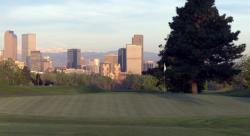City Park Golf Course in Denver has been around for almost a century, so change isn’t taken lightly.
After all, this is a place where sports standouts ranging from Joe Louis to Babe Zaharias to Charlie Sifford to Jonathan Kaye have played at various times over the decades. And the Denver public course has a longstanding reputation for being a good place to find a money game.
With all the history at the 98-year-old layout, it was no surprise that a decision implemented 2½ years ago was met with a certain sense of sacrilege by longtime City Park regulars. In the spring of 2008, the course’s nines were switched with the hope that the change would result in a faster pace of play and better services when players made the turn.
But most golfers who frequent City Park never took to the changes, and, after a couple of years, the will of the people prevailed. On July 1 of this year, City Park went back to its traditional course routing, with an 18th hole that comes back to the clubhouse, and the move has been very well received.
“The response has been overwhelmingly positive,” said Keith Soriano, who took over as head professional at the course at the beginning of the year. “The vast majority of the people have been pleased by the switch back.”
In the two weeks before the switch was made this summer, City Park staffers went out on the course and surveyed players, asking which layout they preferred and why. Soriano said that 95 percent of those who responded wanted a return to the traditional routing of the course.
Ed Mate, executive director of the CGA, was a regular at City Park in his youth and is among those happy to see things back the way they were before 2008.
Mate estimates he’s played 300-400 rounds at the course over the years.
“I grew up playing there,” he said. “I tell people, “˜It’s not St. Andrews, but it’s my St. Andrews. It’s not the birthplace of golf, but it’s my birthplace of golf.'”
The traditional “finishing holes at City Park are fabulous, particularly 16, 17 and 18,” Mate said, noting a formidable par-3, a par-5 that provides a good birdie or even eagle opportunity, and a strong dogleg par-4. “So much of what makes a golf course memorable is sequencing, and City Park wasn’t nearly as memorable the other way. It didn’t make any sense to me how they could change it, but now it’s back to being right.”
Dan Hogan, a member of the Colorado Golf Hall of Fame, frequented City Park during the 1950s, ’60s and ’70s and said he’s played “hundreds” of rounds there. He, too, is glad to see things back to normal at the course, which is also known for its nice views of the Denver skyline and the mountains.
“It lost some glamour” when it was originally changed, he said. “I know that several of the better players left because they didn’t like the switch, but they’re back now. The course simply wasn’t as enjoyable. I’ve always thought that you can take the boy out of City Park but you can’t take City Park out of the boy.
“It’s a good, traditional old course, and the 18th is a great finishing hole. I’ve seen a lot of interesting things happen there, both in tournaments and in some pretty good money games, too.”
When Soriano came on board in January, he thought the 2008 rerouting with the switch of the nines was inefficient, but he didn’t want to make any rash changes. “A lot of the regulars have played here for decades,” he said. “And when a new pro comes, everyone wants to get in their ear. But I didn’t want to make a decision based on noise from the crowd.”
So Soriano took the first six months of the year gathering data and soliciting feedback. With the men’s club in favor of returning to the traditional routing, he used their tournaments as experimental trial runs, comparing pace of play on the traditional layout to the one that utilized the switched nines.
“We found (pace of play) was a wash” either way, Soriano reported. “The new layout in 2008 made you start with two long par-5s uphill, and with eight-minute tee times the group ahead (hitting second shots) is not out of the way in time. So you’re immediately behind on pace and it becomes a chain reaction.”
Part of the issue at City Park is that the traditional ninth green isn’t located adjacent to the clubhouse, but rather hundreds of yards away, which doesn’t make it ideal for players who want a snack or to go the restroom at the turn. But when the nines were switched in 2008, that led to other issues, most notably a first and 18th hole not in close proximity to the clubhouse.
Beginning in 2008, a starter had to be utilized to monitor the first tee. Now, Soriano says, there’s no need for a starter; calls to the tee are made with the clubhouse public address system.
“It runs more efficiently this way,” Soriano said.


